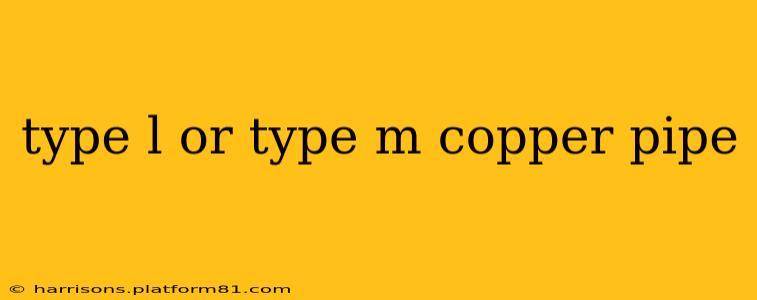Choosing the right type of copper pipe is crucial for any plumbing project, ensuring durability, safety, and longevity. Two common types are Type L and Type M copper pipes, each with distinct characteristics that suit different applications. This guide will delve into the key differences between Type L and Type M copper pipes, helping you make an informed decision for your next plumbing project.
What is Type L Copper Pipe?
Type L copper pipe is known for its thick walls, making it the strongest and most durable of the common copper pipe types. This robust construction allows it to withstand higher water pressures and temperatures, making it ideal for underground installations, high-pressure systems, and applications where significant stress is anticipated. Its thicker walls also contribute to its excellent resistance to collapse under external pressure. Due to its strength and reliability, Type L is often preferred for commercial applications and large-scale projects.
What is Type M Copper Pipe?
Type M copper pipe has thinner walls compared to Type L. While still robust, it offers a balance between strength and cost-effectiveness. This makes it a popular choice for residential plumbing systems where pressure demands are generally lower. Type M is also easier to bend and work with, speeding up installation time and potentially reducing labor costs. It’s a versatile option suitable for various indoor applications.
Type L vs. Type M: Key Differences Summarized
| Feature | Type L Copper Pipe | Type M Copper Pipe |
|---|---|---|
| Wall Thickness | Thickest | Thinner |
| Strength | Highest | Moderate |
| Pressure Rating | Highest | Lower |
| Cost | Typically More Expensive | Typically Less Expensive |
| Applications | Underground, high-pressure systems | Residential plumbing, indoor applications |
| Workability | More difficult to bend | Easier to bend |
What are the common applications for Type L and Type M copper pipes?
Type L Copper Pipe Applications:
- Underground piping: Its superior strength safeguards against ground shifting and external pressures.
- High-rise buildings: Able to handle the significant water pressure in tall structures.
- Industrial applications: Withstands demanding conditions and high-pressure requirements.
- High-pressure water systems: Ensures reliable performance in demanding systems.
Type M Copper Pipe Applications:
- Residential plumbing: A cost-effective and suitable choice for most household plumbing needs.
- Indoor plumbing: Suitable for various indoor applications where pressure demands are lower.
- Low-pressure water systems: Provides reliable performance in less demanding systems.
Which type of copper pipe is right for me?
The best choice depends on your specific project needs. Consider these factors:
- Water pressure: High-pressure systems necessitate Type L; lower-pressure systems can utilize Type M.
- Installation location: Underground or exposed locations may require the added durability of Type L.
- Budget: Type M generally provides a more cost-effective solution.
- Ease of installation: Type M is easier to work with, potentially saving on installation time and labor costs.
Ultimately, consulting with a qualified plumber is always recommended to determine the most appropriate pipe type for your plumbing project. They can assess your specific requirements and advise on the best solution to ensure safety, durability, and compliance with building codes.
What are the different types of copper pipe fittings?
Various fittings are available for both Type L and Type M copper pipes, including compression fittings, soldered fittings, and flare fittings. The choice of fitting depends on factors such as the application, budget, and installer's preference. Proper installation of fittings is crucial to ensure a leak-free and long-lasting plumbing system. This would merit a separate article to discuss comprehensively.
How long does copper pipe last?
With proper installation and maintenance, copper pipe can last for 50 years or more. Its inherent resistance to corrosion and durability contributes to its long lifespan. However, factors such as water quality, soil conditions (for underground installations), and the presence of aggressive chemicals can affect its longevity.
Remember, this information is for guidance only. Consult with a professional plumber for expert advice tailored to your specific project.
